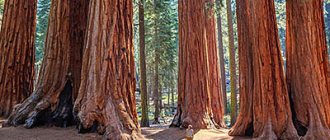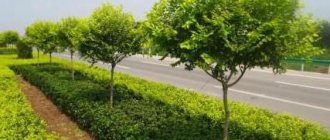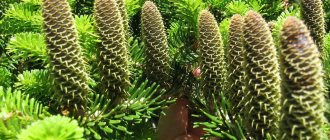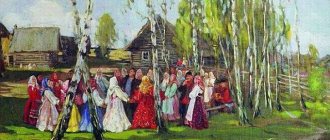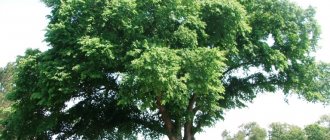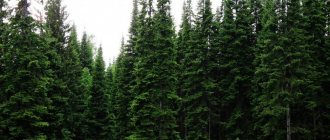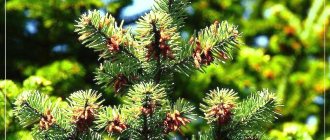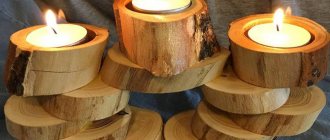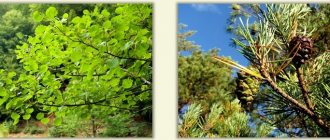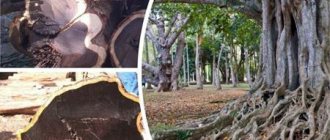Features of cedar
The height of a cedar can reach up to 50 meters, while the diameter of its trunk can be from 2 to 3 meters. The trunk and stems are covered with gray bark. While the plant is young, its bark is smooth and thin, but over the years it becomes thicker and a large number of cracks appear on it. The root system easily adapts to new conditions, while its shape directly depends on the characteristics of the soil, but it is often superficial with many adventitious processes. One of the main factors that influences the formation of a branched root system is the presence of moss cover.
Three- or tetrahedral needle-shaped needles are represented by pointed needles. In some species it is soft (for example, Cedrus atlantica), while in others it is highly rigid (for example, Cedrus libani). The color of the needles can vary from silver to bright green.
This tree blooms in autumn. It is monoecious, that is, spike-shaped inflorescences consisting of female or male flowers are formed on its branches. The elongated and erect cones have a light blue tint. At the same time, ripe cones turn brown. The plant is distinguished by late fruiting; the first cones form on the tree only after it is 20 to 25 years old. The ripening of the cone lasts from 2 to 3 years, with the seeds falling out in the autumn-winter period.
Cedar (Cedrus) is often confused with cedar pine. This conventional name refers to several species belonging to the genus Pine (Pinus), for example: European, Korean, Siberian and dwarf pine. Such trees have edible seeds called “pine nuts.” But from a scientific point of view, they are not cedar fruits or nuts; a more accurate name for such a product could be “pine seeds.” The fruits of cedar are not eaten.
The average lifespan of such a tree is about 1 thousand years. The oldest cedar is located in Japan on the island of Yakushima; its age, according to various sources, is from 3 to 7 thousand years. Over the years, cedar begins to grow differently. The young tree is characterized by rapid growth, while the adult plant grows moderately, during the year its growth ranges from 20 to 30 centimeters.
Cedar pines
Siberian cedar: description
Siberian cedar (sometimes also called Siberian or cedar pine) is an evergreen tree with a powerful physique and noble roots. Its distribution area is Siberia, the Urals, Mongolia, China. Cedar is shade-tolerant and loves moist, light, sandy or loamy soil with good drainage. In dry years, it requires abundant watering and spraying of seedlings.
Siberian cedar, or Siberian pine, is undoubtedly the king of all trees in the taiga zone
Siberian pine is a long-liver: it can live up to 800 years. In the first years it actively absorbs moisture from the soil, and after 80 it releases it. The height of such a hero reaches 45 m with a maximum trunk diameter of 2 m or more. They are grown by seeds or seedlings.
Cedar pine belongs to the Pine family. It has a dense evergreen crown; there are also specimens with several tops. There are many knots on the gray-brown trunk; the bark of aging trees cracks and resembles scales. The needles of Siberian pine are soft, dark green in color with a gray coating. The length of the needles (there will be 5 of them in a bunch) is about 15 cm. This tree species grows slowly.
Their growing season is short: approximately 50 days. The root system is unusual: a short (no more than half a meter) tap-type main root branches into many small lateral roots with hairs. They contain fungal roots.
If the soil for cedar is suitable, then powerful anchor roots grow on the main rhizome, growing 3 m deep. They, together with the lower paws, are responsible for the stable position of the cedar.
Powerful anchor roots of Siberian cedar
Cedar pine is known for its seeds - nuts. Cedar is a tree of the monoecious, dioecious family. Both male and female cones in the shape of a cone coexist quietly on the same tree. The first are formed at the base, the second - at the ends of the sprout shoot (at the apical bud). The wind pollinates them.
Ripe cones are large (15 x 8 cm). Young cones have a purple color, gradually turning into brown. The shape of the fruit also changes: at first it resembles an egg, then in cross-section it looks like a diamond. The scales of the cones are tightly compressed; for the fruit to fully ripen, it will take at least 15 months.
The cedar nuts are dark brown, also oval in shape, dimensions 10x15 mm. Giants begin to bear fruit in the 60th year of their life - impressive (when compared with human life). In one season in a harvest year, you can collect up to one and a half thousand cones from one cedar.
Cedar nuts are dark brown
Types of cedar with photos and names
The cedar genus includes 4 species, namely: Lebanese (C. libani), Cypriot or short-coniferous (C. brevifolia), Himalayan (C. deodara) and Atlas (C. atlantica). Often, plants that are not part of the genus Cedar (Cedrus) are called cedar. For example, Siberian cedar is actually Siberian pine. Caucasian cedar is often called C. Deodara, while Karelian cedar is the name given to a variety of conifers that are found in Karelian forests.
Himalayan cedar (Cedrus deodara)
This plant is characterized by rapid growth, reaching a height of about 50 meters. Hanging horizontal stems form a wide cone-shaped crown. Quite soft, lush, straight needles have a greenish-silver color, and their length can vary from 20 to 50 mm. While the cones are young, their color is bluish-green, but as they ripen they turn brownish-red. The surface root system has many shoots, and the plant is not wind-resistant. It is found in the mountains at an altitude of up to 3.5 thousand meters above sea level. The average life expectancy is about 3 thousand years. Despite the fact that the wood is soft, it is highly durable.
Cedar of Lebanon (Cedrus libani)
This tree can reach a height of 30 to 40 meters. The shape of the crown becomes umbrella-shaped over the years. Strong branches extend from the trunk at an oblique angle. The length of the needles is about 40 mm; in some forms it is light blue, while in others it is bright green. The cones are pale brown in color. This type of wood is red, it is soft and light.
Atlas cedar (Cedrus atlantica)
This evergreen plant has a height of 40 to 50 meters, and its trunk reaches about 200 cm in diameter. The silvery lush needles are quite short (length about 25 mm). The fragrant wood has a smell similar to sandalwood. This plant is drought-resistant; unlike other species, it is not harmed by prolonged frosts down to minus 20 degrees.
Short-coniferous cedar (Cedrus brevifolia)
A low-growing tree, the average height of which reaches about 15 meters. Its short (about 1 cm) needles are colored greenish-blue. This is a variety of Lebanese cedar.
Different types of cedar easily form interspecific hybrids. Hybrid forms formed between species such as Atlas and Himalayan have become quite widespread.
About different varieties of cedar
Varieties and varieties of cedar wood
Cedar belongs to the family of coniferous, evergreen trees. The cedar pine has quite impressive dimensions - the height of some specimens reaches fifty meters. If you look at the photo of a cedar tree, you can see how diverse the species shades of this tree are.
The characteristic features of cedar include:
- dark brown bark color
- specific woody smell
- single, erect cones
Today, cedar wood has a lot of varieties, some of them are worth dwelling on in more detail.
Cedar distribution
In nature, cedars are found in the southern and eastern regions. Moreover, such a tree is most often found in mountainous areas. Different species have different habitats:
- Himalayan cedar . This species is most widespread in the Himalayas, Afghanistan. Since the end of the 19th century, the tree has been cultivated in Russia and Europe. It is found in the Caucasus, Crimea and the Black Sea coast.
- Lebanese cedar . It is found in Turkey, Abkhazia and Lebanon.
- Atlas cedar . It grows in Algeria, Abkhazia and Morocco.
- Short needle cedar . This species grows on the island of Cyprus.
The tree grows and develops best on uncompacted soil, which contains very little lime. In the wild, it prefers to grow in mixed forests; its neighbors are fir, spruce and pine. There are also cedar forests; only cedars grow in such a forest. This plant is often used for landscaping parks. This is a rather heat-loving tree, so it does not grow in Karelia, as well as in Eastern and Western Siberia, where the climate is quite harsh and frosty.
Lebanese cedar
A mature tree is distinguished by the presence of a spreading crown, which contrasts brightly with the separated belts of branches. Sufficiently young cedars have the configuration of a sharp cone. Cedar is not picky about the soil on which it grows. Cedar pine feels great on both limestone and loam.
Lebanese cedar is distinguished by its swamp color, the length of coniferous needles reaches 30 mm. The cedar tree cone has a light brown color, is quite large, and reaches a length of 12 cm.
Planting and caring for cedar
Planting in open ground
Cedar has a root system in the top layer of soil. In this regard, for planting, it is recommended to choose an area with loose soil, and the top layer should be saturated with nutrients. Moisture- and breathable loam is best suited for such a plant. It has low resistance to wind, so the suitable site must be protected from strong gusts of wind and hurricanes. Therefore, it is not recommended to plant such a tree on the seashore. This shade-tolerant crop grows well in a shaded area.
Cedar is highly resistant to drought. It needs to be watered moderately, because it can suffer greatly from stagnation of water in the root system. In conditions of high humidity, it is recommended to ensure that the soil does not become waterlogged, especially if it is calcareous, because this can cause chlorosis. The plant responds well to loosening the soil, as this helps improve its oxygen supply.
In the southern regions, such a tree is grown both from seeds and seedlings, and propagated by grafting onto pine trees. When choosing a place to plant cedar, you should take into account that it has a fairly wide and spreading crown, so it needs a large amount of free space. If you decide to purchase a ready-made seedling, then in this case it is recommended to give preference to a closed root system.
Features of planting in open ground:
- It is recommended to plant cedar in the garden in autumn or spring;
- the seedling is planted in a prepared hole, while the earthen ball should be kept intact;
- if the seedling has an open root system, then it is planted in a permanent place as quickly as possible;
- dig up the soil on the site in advance, then prepare a hole for planting, the size of which should be 30 percent larger than the root system along with a lump of earth;
- if the soil on the site is depleted, then humus or peat is added to it;
- the root system is characterized by increased sensitivity to stagnation of liquid in the soil, so at the bottom of the pit a layer of drainage 10 centimeters thick must be made, for this they use expanded clay, pebbles or brick fragments;
- You can install a peg to secure the seedling.
The planted tree must be well watered. To slow down the evaporation of water from the soil, the surface of the tree trunk circle should be covered with a layer of mulch about 50 mm thick; for this you can use crushed bark, pine needles, peat or dry grass. Over time, the mulch layer begins to rot and release nutrients into the soil.
how to grow cedar
Cedar care
Cedar is watered only in the summer during a prolonged drought. In this case, the soil should be moistened moderately.
Cedar is fed relatively rarely. This procedure is recommended to be carried out only once during the season. For this purpose, a mineral complex for conifers is used. You can also use organic fertilizer, for example, compost or vermicompost.
In autumn and spring, young stems are pruned, and the cut areas are treated with garden varnish. Using formative pruning, a spreading crown is created. In order to prevent various diseases, experts recommend systematically carrying out sanitary pruning, cutting out all dried branches, and also clearing the soil surface of flying needles.
In late autumn, the tree is insulated. To cover the trunk, burlap, agrofibre, spruce branches (coniferous branches) are used, and you can also sprinkle it with peat with a thickness of 50 to 70 mm.
Planting cedar on a summer cottage
The pit intended for planting seedlings should not be closer than three meters from buildings, and up to ten meters from the nearest bushes with spreading crowns.
The dimensions of the hole prepared for planting should be about one and a half meters in diameter and one meter deep. Drainage (expanded clay) is laid at the bottom of the pit, the layer of which is about 0.2 m. A layer of fertile soil 80 cm thick is laid on top of the drainage layer.
The seedling is placed on a planting mound and covered with earth. The watering rate for a small two-year-old seedling is at least ten liters.
What a cedar tree will look like on a personal plot largely depends on the gardener. Growing cedar does not require special skills, but at the same time, following certain rules when planting and caring for it will give the expected result.
Reproduction methods
Growing from seeds
Flowering of cedar is observed in autumn, and pollination occurs with the help of the wind. Under natural conditions, such a tree reproduces by seed. Cones ripen once every 2 or 3 years. The scattering of a fully ripened cone occurs in the last autumn or first winter weeks. The seeds of such a plant are often called nuts or nuts, but from a scientific point of view this is a misconception. The surface of the seeds is covered with a thin peel; they have relatively large lionfish. The seeds are highly resinous, thanks to this they are reliably protected from rodents, and this also helps to increase their germination.
Once the seeds are in the ground, the first seedlings can be seen in about 20 days. If you decide to propagate cedar by seeds, then you must adhere to the following rules:
- cones should be collected in late autumn, and they should be healthy and fully ripened;
- seed material should be placed in water for 2 or 3 days for germination, and it should be systematically replaced with fresh water;
- then the seeds are placed for several hours in a solution of potassium manganese, this is necessary to prevent diseases caused by pathogenic microbes;
- the seed material must undergo stratification for three months, it is buried in moistened sawdust or peat and placed in a place with a temperature of approximately 5 degrees;
- immediately before sowing, the seeds are again kept in a solution of potassium manganese;
- at the beginning of the spring period, they are sown in a box filled with substrate, while they are buried by 20–30 mm, and the top is covered with film;
- the substrate should be mixed with wood ash, superphosphate and peat, while its surface should be covered with a layer of sawdust.
The shelter is removed only after the seedling is 2 years old. The seedling is planted in a permanent place when it is five years old. Planting is carried out in autumn or early spring.
How to grow cedar, Growing cedars.
Cuttings
This tree is also propagated by cuttings. This method is quite fast and helps preserve the cedar variety. Rules:
- cuttings are prepared in spring on a cloudy day;
- It is recommended to cut them from a young tree;
- a very sharp tool is used for cutting; the cutting can also be torn off with a quick downward movement;
- the cutting should have a “heel” - this is a small part of the bark with a layer of wood;
- the lower part is dipped in a product that stimulates root growth;
- When planting for rooting, you should maintain orientation to the cardinal points.
Provide the cuttings with warmth and moderate humidity; disease prevention is also important. The first roots should form after six months. Not all cuttings take root, and this method is quite complicated. That is why cuttings are carried out only in the nursery. Inexperienced gardeners are advised to purchase a ready-made seedling for planting.
Usage
People have long noticed the beneficial properties of cedar wood and found it used in all spheres of human activity: houses, furniture and other wooden crafts are made from wood. Russian cedars are also used in medicine and cooking: food is prepared from the seeds, cedar vegetable oil is used, medicinal decoctions and cedar essential oil are prepared from pine bark and oleoresin.
Oil
Cedar oil is so unique that there is no oil equal to it in terms of its properties. Pine nut oil is made by pressing the seeds of Siberian pine, and it contains all the beneficial properties inherent in olive, coconut, sea buckthorn and burdock oils. For example, pine nut oil contains five times more vitamin E than olive oil.
Cedar essential oil is obtained both from real wood and from Siberian pine, thuja and other coniferous plants (the properties differ little from each other and the main difference is in the ratio of components).
Unlike vegetable oil, cedar essential oil is made from crushed bark, wood, and young shoots. Cedar essential oil has excellent antiseptic, soothing, and antiviral properties; it is successfully used in cosmetology. The only thing is that cedar essential oil is not taken internally: it is inhaled, applied to the skin, and used for healing baths and other procedures.
Sap
Also successfully used in treatment is cedar resin (tree resin), which undergoes pre-treatment: it cannot be used in its pure form, since it hardens quickly.
Basically, cedar resin is also successfully used in solutions that you can either prepare yourself or purchase in a store. It is simple to make: cedar resin dissolves well in any vegetable oil at a temperature of 50 degrees and since the components do not overheat, it does not lose its healing properties and, when used correctly, cures.
Cedar resin is also sold in stores, but the person purchasing the solution should take into account that, most likely, they will buy a fake. For example, a solution called “Turpentine oil” is made from corn and nut oils, and “Turpentine oil” is turpentine turpentine, since it is obtained when cedar oleoresin is distilled with water or steam (in its beneficial properties, such a solution is very different from dissolved in oleoresin oil).
Diseases and pests
The most dangerous for cedar are silkworm caterpillars and borers. Much less often, the plant is affected by aphids, hermes and scale insects. Control pests with suitable insecticidal agents.
The tree is susceptible to fungal diseases. Most often it is affected by root rot, which is caused by fungi of the genus Fusarium and Pythium. For prevention purposes, it is necessary to control soil moisture and air permeability. Remember, stagnation of water is detrimental to the plant. In a diseased plant, a whitish coating forms at the base of the trunk. If the disease is severe, then the needles may fall off. Treat the diseased plant with a fungicidal preparation as soon as possible. Diseased branches are cut off and destroyed by fire. Brown rot and rust are also dangerous for cedar. Because of them, the needles suffer, which turn yellow and fly off.
If a tree grows in dry soil rich in lime, then this can cause the development of chlorosis. For preventive purposes, loosen the soil surface.
How to save cedar from a pest. Garden head
Use of cedar
The use of cedar raw materials in various industries and medicine cannot be underestimated. Pine needles, as well as its cones and nuts, are widely used in the pharmaceutical industry.
The materials obtained as a result of processing cedar contain a huge amount of useful substances, without which it is necessary to treat many diseases.
Application of cedar
Cedars growing in the southern climate are used to harvest valuable heartwood, which is highly durable. Decorative items and crafts, as well as cedar furniture, are quite popular. This wood is also widely used in construction, shipbuilding, and also in the manufacture of underwater structures. Since the wood is soft, it can be easily processed. This wood is very similar to larch, but it is lighter and stands out for its whiteness, but is less durable.
The resin is used to produce rosin, which is used in soldering work and for the manufacture of varnishes. When the sap of such a tree hardens, it forms amber, which is widely used in the production of medical instruments, as well as in jewelry.
The needles are used in the perfume industry. An essential oil is made from it with an antimicrobial effect, as well as a pleasant pine scent, which soothes and helps get rid of anxiety. A decoction made from pine needles is rich in vitamin C, which can help with colds and scurvy.
MIGHTY CEDAR || Useful properties and applications
Description of cedar wood
Cedar pine, which is the second name for cedar, has a light core with a yellow or pink tint. It is practically no different from sapwood. The resin passages of cedar are smaller than those of pine. But at the same time they are more clearly expressed.
GOST 20022. 2-80 classifies cedar as a resistant species that very rarely rots. But at the same time, cedar wood is very soft and can be processed perfectly in all directions.
In Siberia, houses are still built from cedar. Moreover, as practice shows, they can last more than a hundred years.
They also make from cedar:
- pencils;
- plywood;
- veneer;
- furniture;
- racks for mining production;
- hives;
- musical instruments;
The life expectancy of cedar is quite high. So, it can exist up to 4 centuries. In the Baltics there is a long-lived cedar, which is 1,500 years old. Therefore, it is impossible to unequivocally answer the question of how many years a cedar tree lives.
It is worth mentioning the beneficial properties of cedar:
Cedar in landscape design
Thanks to their spreading, spectacular crown, cedars are widely used for landscaping public gardens and parks. The trunk can be about 50 meters high, so cedar is suitable for forming alleys. It is used for both single and group planting.
In landscape design, weeping forms are most often used, as well as varieties with blue and silver needles. The decorative form of C. deodara Pendula is quite widespread in culture - it is a low-growing plant with hanging arcuate stems, which are decorated with bright green needles.
Young cedars are suitable for creating hedges. This tree goes well with other conifers and low decorative deciduous crops. Dwarf varieties are often used to decorate Japanese-style stone gardens, as well as for topiary and bonsai.
Formation of a cedar crown
Atlantic cedar
This variety of cedar pine is characterized by fairly rapid growth at a young age. It is able to withstand very well both severe cold and dry summers.
A large amount of moisture can negatively affect it, and the tree may die, so you should not plant the plant in soil with a high groundwater level.
Interesting facts about cedar
Cedar is one of those rare trees, all parts of which are used for food or medicinal purposes.
Cedar forests have such intense phytoncidal power that one hectare of such forest would be enough to purify the air in an entire city.
The ancient Sumerians revered cedar as a sacred tree and gave names to the most majestic specimens. Cedar wood served as a measure of exchange and was often valued more than gold. The Sumerian god Ea was considered the patron of cedar, and no one could cut down this tree without the highest permission. These facts are confirmed by clay tablets found during excavations, which date back to the 5th–4th centuries. BC. A description of what cedar looks like was written on them.
The decoration of the tomb of the Egyptian king Tutankhamun is made of cedar wood. For 3 thousand years, it not only did not deteriorate, but even retained its delicate delicate smell. Due to its properties, cedar resin was one of the components of mummifying mixtures, and cedar oil helped preserve priceless ancient Egyptian papyri to this day.
The ancients built their ships from cedar wood, and the wonderful gopher tree, from which Noah built his ark, is a cedar that grows in the valleys of Mesopotamia.

